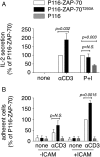Intensity and duration of TCR signaling is limited by p38 phosphorylation of ZAP-70T293 and destabilization of the signalosome
- PMID: 29440413
- PMCID: PMC5834678
- DOI: 10.1073/pnas.1713301115
Intensity and duration of TCR signaling is limited by p38 phosphorylation of ZAP-70T293 and destabilization of the signalosome
Abstract
ZAP-70 is a tyrosine kinase that is essential for initiation of T cell antigen receptor (TCR) signaling. We have found that T cell p38 MAP kinase (MAPK), which is directly phosphorylated and activated by ZAP-70 downstream of the TCR, in turn phosphorylates Thr-293 in the interdomain B region of ZAP-70. Mutant T cells expressing ZAP-70 with an alanine substitution at this residue (ZAP-70T293A) had enhanced TCR proximal signaling and increased effector responses. Lack of ZAP-70T293 phosphorylation increased association of ZAP-70 with the TCR and prolonged the existence of TCR signaling microclusters. These results identify a tight negative feedback loop in which ZAP-70-activated p38 reciprocally phosphorylates ZAP-70 and destabilizes the signaling complex.
Keywords: MAP kinase; T cell antigen receptor; immune synapse; signal transduction.
Conflict of interest statement
The authors declare no conflict of interest.
Figures





Similar articles
-
TCR and CD28 are coupled via ZAP-70 to the activation of the Vav/Rac-1-/PAK-1/p38 MAPK signaling pathway.J Immunol. 1999 Jul 15;163(2):844-53. J Immunol. 1999. PMID: 10395678
-
Extracellular acidic environments induce phosphorylation of ZAP-70 in Jurkat T cells.Immunol Lett. 2008 Jan 29;115(2):105-9. doi: 10.1016/j.imlet.2007.10.006. Epub 2007 Oct 31. Immunol Lett. 2008. PMID: 18022252
-
The catalytic activity of the kinase ZAP-70 mediates basal signaling and negative feedback of the T cell receptor pathway.Sci Signal. 2015 May 19;8(377):ra49. doi: 10.1126/scisignal.2005596. Sci Signal. 2015. PMID: 25990959 Free PMC article.
-
ZAP-70 in Signaling, Biology, and Disease.Annu Rev Immunol. 2018 Apr 26;36:127-156. doi: 10.1146/annurev-immunol-042617-053335. Epub 2017 Dec 13. Annu Rev Immunol. 2018. PMID: 29237129 Review.
-
Activating p38 MAPK: new tricks for an old kinase.Cell Cycle. 2005 Sep;4(9):1189-92. doi: 10.4161/cc.4.9.2043. Epub 2005 Sep 20. Cell Cycle. 2005. PMID: 16103752 Review.
Cited by
-
MicroRNA expression profile in chronic nonbacterial prostatitis revealed by next-generation small RNA sequencing.Asian J Androl. 2019 Jul-Aug;21(4):351-359. doi: 10.4103/aja.aja_97_18. Asian J Androl. 2019. PMID: 30604696 Free PMC article.
-
Inhibition of T Cell Receptor Activation by Semi-Synthetic Sesquiterpene Lactone Derivatives and Molecular Modeling of Their Interaction with Glutathione and Tyrosine Kinase ZAP-70.Molecules. 2019 Jan 19;24(2):350. doi: 10.3390/molecules24020350. Molecules. 2019. PMID: 30669433 Free PMC article.
-
INPP5E regulates CD3ζ enrichment at the immune synapse by phosphoinositide distribution control.Commun Biol. 2023 Sep 5;6(1):911. doi: 10.1038/s42003-023-05269-0. Commun Biol. 2023. PMID: 37670137 Free PMC article.
-
Diversity and versatility of p38 kinase signalling in health and disease.Nat Rev Mol Cell Biol. 2021 May;22(5):346-366. doi: 10.1038/s41580-020-00322-w. Epub 2021 Jan 27. Nat Rev Mol Cell Biol. 2021. PMID: 33504982 Free PMC article. Review.
-
Fluid shear stress enhances T cell activation through Piezo1.BMC Biol. 2022 Mar 9;20(1):61. doi: 10.1186/s12915-022-01266-7. BMC Biol. 2022. PMID: 35260156 Free PMC article.
References
Publication types
MeSH terms
Substances
LinkOut - more resources
Full Text Sources
Other Literature Sources
Molecular Biology Databases
Research Materials

